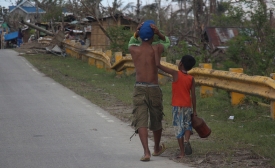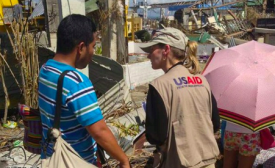aid diplomacy
Since Typhoon Haiyan struck the Philippines a month ago, the world has wanted to help the devastated areas. Yet as we’ve seen in the wake of other mega-disasters, well-meaning assistance to shattered communities can cause more harm than good. Let’s lay to rest some of the biggest misconceptions about how best to help victims of storms, earthquakes and other calamities.
Public diplomacy (PD), if defined as the act of a government engaging directly with a foreign public, then many governments are currently conducting PD towards the Filipino public in the aftermath of Typhoon Haiyan's devastation. Most public diplomacy scholars and practitioners refer to the foreign aid assistance in the wake of a disaster as "aid diplomacy."

Public diplomacy (PD), if defined as the act of a government engaging directly with a foreign public, then many governments are currently conducting PD towards the Filipino public in the aftermath of Typhoon Haiyan's devastation.

Public diplomacy (PD), if defined as the act of a government engaging directly with a foreign public, then many governments are currently conducting PD towards the Filipino public in the aftermath of Typhoon Haiyan's devastation. Most public diplomacy scholars and practitioners refer to the foreign aid assistance in the wake of a disaster as "aid diplomacy." This aid diplomacy is often spoken about in terms of foreign aid packages, goodwill gestures, and how foreign aid can help to increase a public's positive attitudes towards the aid-providing country.
Myanmar's president called Thursday for more investment and development assistance from the Philippines, saying his country needs help to catch up with the rest of Southeast Asia after emerging from nearly two decades of economic sanctions. President Thein Sein's visit represents a milestone in relations with the Philippines, one of the harshest critics of Myanmar's former ruling junta.
Despite impressive changes over the past three years, Myanmar (or Burma) now faces growing insecurity and rising disappointment among citizens that reform has not brought higher standards of living. Interethnic and interreligious unrest now threaten to halt reforms altogether, depress much-needed investment, and could even lead to broader regional tensions.
On November 8, 2013, Super Typhoon Haiyan ravished the Philippine archipelago. With 195 MPH winds and gusts of up to 230 MPH, the typhoon killed an estimated 4,000 people and displaced another 670,000. Across the southern part of the Philippines and especially in Tacloban, the city most affected by the typhoon, the scene is apocalyptic.
Health agencies are warning of an “alarming” increase in AIDS-related deaths among adolescents, a new front line in the fight against a global epidemic that has waned in recent years. This worrying new trend is a setback for efforts to eradicate the virus, according to a United Nations report released ahead of World AIDS Day on Dec. 1. Among youth aged 10 to 19, deaths linked to AIDS increased by 50 percent between 2005 and 2012, compared with a 30 percent decline seen in the general population.







